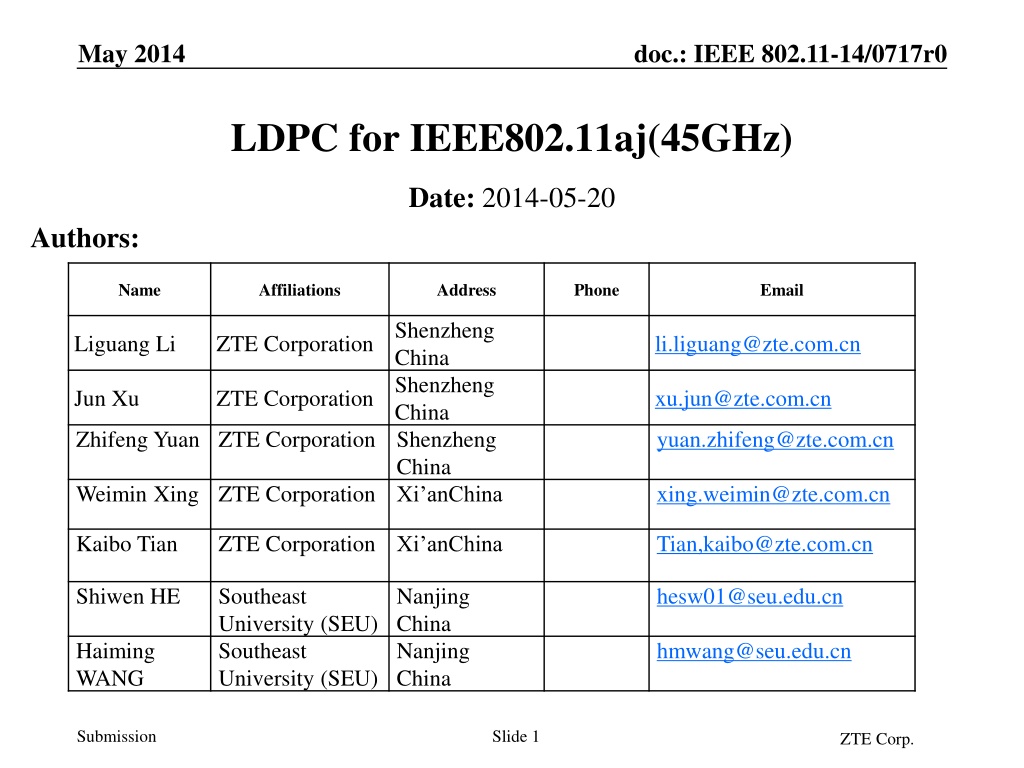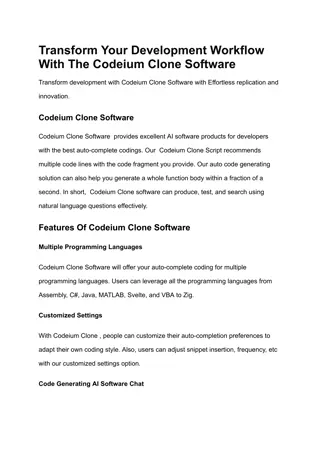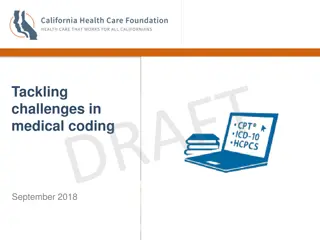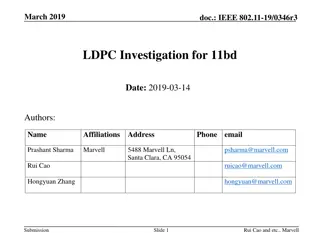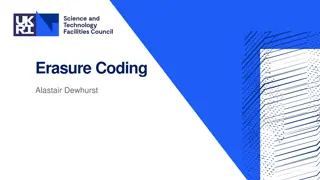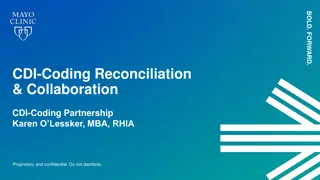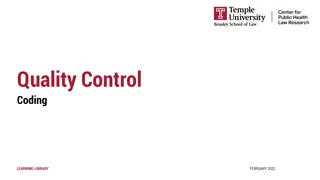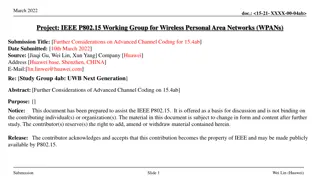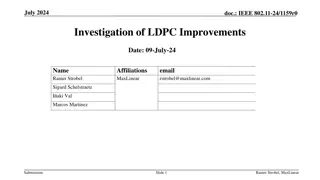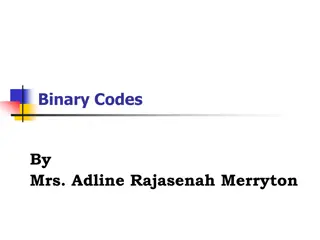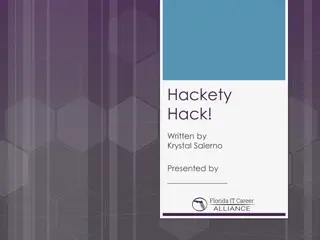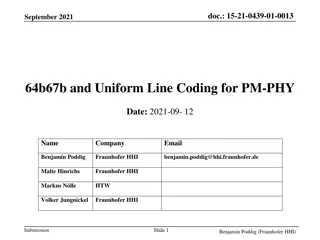LDPC Coding for IEEE802.11aj in 45GHz
LDPC coding has been integral in various IEEE standards for wireless communication, offering high performance with low complexity through different code rates and lengths. This document delves into LDPC usage in IEEE802.11aj at 45GHz, discussing background information, decoding algorithms, issues with 802.11ad LDPC, and a proposed LDPC base matrix. It also outlines code rates, systematic bits, and expansion factors for different rates, providing insights into LDPC design and implementation for wireless networks.
Download Presentation

Please find below an Image/Link to download the presentation.
The content on the website is provided AS IS for your information and personal use only. It may not be sold, licensed, or shared on other websites without obtaining consent from the author.If you encounter any issues during the download, it is possible that the publisher has removed the file from their server.
You are allowed to download the files provided on this website for personal or commercial use, subject to the condition that they are used lawfully. All files are the property of their respective owners.
The content on the website is provided AS IS for your information and personal use only. It may not be sold, licensed, or shared on other websites without obtaining consent from the author.
E N D
Presentation Transcript
May 2014 doc.: IEEE 802.11-14/0717r0 LDPC for IEEE802.11aj(45GHz) Date: 2014-05-20 Authors: Name Affiliations Address Phone Email Shenzheng China Shenzheng China Shenzheng China Xi anChina Liguang Li ZTE Corporation li.liguang@zte.com.cn Jun Xu ZTE Corporation xu.jun@zte.com.cn Zhifeng Yuan ZTE Corporation yuan.zhifeng@zte.com.cn Weimin Xing ZTE Corporation xing.weimin@zte.com.cn Kaibo Tian ZTE Corporation Tian,kaibo@zte.com.cn Xi anChina Shiwen HE Southeast University (SEU) Southeast University (SEU) Nanjing China Nanjing China hesw01@seu.edu.cn Haiming WANG hmwang@seu.edu.cn Submission Slide 1 ZTE Corp.
May 2014 doc.: IEEE 802.11-14/0717r0 Background LDPC have been used in several IEEE standards, it can provide high performance with low complexity by using different code rates and code lengths In 802.11n/ac, 12 check matrixes were used, supporting 4 code rates and 3 code lengths. In 802.11ad, , 4 check matrixes were used, supporting 4 code rates and fixed code length. In 802.16e, 6 check matrixes were used, supporting 4 code rates and 19 code lengths. Submission Slide 2 ZTE Corp.
May 2014 doc.: IEEE 802.11-14/0717r0 Background Decoding algorithm of LDPC Probability domain BP decoding algorithm Log-domain BP decoding algorithm min-sum decoding algorithm Decoder architecture Ordinary decoder: High complexity, more iteration, low throughput Layered decoder: High complexity, less iteration, moderate throughput, wide used Submission Slide 3 ZTE Corp.
May 2014 doc.: IEEE 802.11-14/0717r0 The issues of 802.11ad LDPC Address conflict will occur in the pipeline decoder no relevance between the two adjacent elements unequal to -1 in one column of base matrix. High complexity interleaver and deinterleaver. all the elements which are not equal to -1 in the same column of different base matrixes are random, so complexityBanyan decoding network is needed. More cyclic shift operation is needed the check part of base matrix is not strictly lower triangular matrix Submission Slide 4 ZTE Corp.
May 2014 doc.: IEEE 802.11-14/0717r0 Proposed LDPC base matrix Feature Most of elements unequal to -1 are even address conflicts can be avoided and decoding clock will be saved. All the elements unequal to -1 in the same column of different base matrixes are from a set with 4 elements Low complexity fixed network can be used instead of Banyan network The first element unequal to -1 of every column is equal to zero. Less cyclic shift operation The check parts of all base matrix are strictly lower triangular matrix. Less cyclic shift operation Submission Slide 5 ZTE Corp.
May 2014 doc.: IEEE 802.11-14/0717r0 Proposed base matrix The code size n=672, and the four code rates are r0=1/2, r1=5/8, r2=3/4 and r3=13/16 respectively, the number of systematic bits corresponding to the four code rates is k0=336, k1=420, k2=504 and k3=546 respectively, and the expansion factor z=42. r0=1/2 0 -1 -1 34 -1 12 -1 36 8 -1 0 -1 0 -1 0 -1 -1 16 40 -1 32 -1 22 -1 -1 20 -1 22 -1 2 -1 28 30 -1 18 -1 -1 14 -1 30 40 -1 12 -1 38 -1 6 -1 -1 24 -1 20 10 -1 2 -1 -1 0 -1 0 -1 0 -1 0 0 18 -1 -1 32 -1 -1 -1 -1 0 13 -1 -1 37 -1 -1 -1 -1 0 19 -1 -1 26 -1 -1 -1 -1 0 21 -1 -1 18 -1 -1 -1 -1 0 31 -1 -1 -1 -1 -1 -1 -1 0 13 -1 -1 -1 -1 -1 -1 -1 0 5 -1 -1 -1 -1 -1 -1 -1 0 r1=5/8 -1 0 8 30 -1 40 0 -1 0 40 18 -1 12 0 0 0 0 0 0 -1 0 -1 13 37 19 0 -1 0 21 -1 -1 -1 -1 -1 0 31 -1 -1 -1 -1 -1 0 13 -1 -1 -1 -1 -1 0 5 -1 -1 -1 -1 -1 0 -1 16 20 24 -1 -1 34 22 20 -1 32 -1 38 -1 10 -1 12 -1 2 14 22 -1 6 -1 2 -1 36 -1 28 30 18 32 -1 16 -1 19 -1 -1 -1 -1 Submission Slide 6 ZTE
May 2014 doc.: IEEE 802.11-14/0717r0 Proposed base matrix r0=3/4 0 8 0 0 0 0 0 0 0 0 0 0 0 0 0 -1 0 -1 13 -1 -1 0 5 -1 -1 -1 0 16 20 24 40 18 12 34 22 20 32 38 10 12 2 14 22 6 2 36 28 30 18 32 16 13 37 19 19 26 34 -1 31 -1 30 40 21 18 r1=13/16 0 0 0 0 0 0 2 0 6 2 0 0 0 0 0 0 0 -1 0 5 -1 -1 0 30 40 20 24 18 12 22 20 38 10 28 30 32 16 37 19 26 34 21 18 34 8 -1 13 14 Submission Slide 7 ZTE Corp.
May 2014 doc.: IEEE 802.11-14/0717r0 Signaling field coding Why the signaling field coding need special designed The lowest code rate should be used for signaling field to maintain a robust reception The signaling bits is much less than the systematic bits of the one LDPC code word Submission Slide 8 ZTE Corp.
May 2014 doc.: IEEE 802.11-14/0717r0 Proposed Signaling field Coding Encoding the signaling field with 72 bits the signaling bits can be shown as The length of and are 30 and 42 respectively. the signaling bits repeat once and is encoded to generate the parity sequence with length of 336 bits by using rate 1/2 LDPC code with the element of base matrix . The mother codeword is . And the sequence of first 1024 bits of three copies of is LDPC code output. The location of , and in the base matrix show as: 2 x b = 2 x x [ , x x 1 x ] 1 2 b 1 = hb 2 6 = c [ , ] x b c 1 x Submission Slide 9 ZTE Corp.
May 2014 doc.: IEEE 802.11-14/0717r0 Proposed Signaling field Coding Encoding the Signaling field with 40 bits the signaling bits can be shown as the signaling bits repeat once and is encoded to generate the parity sequence with length of 336 bits by using rate 1/2 LDPC code base matrix . The mother codeword is . And the sequence of first 672 bits of three copies of is LDPC code output. The location of and in the base matrix show as: x b x b c = c [ , ] x b Submission Slide 10 ZTE
May 2014 doc.: IEEE 802.11-14/0717r0 Conclusion We proposed a new LDPC base matrix for group discussion The advantage of the base matrix is that Most of elements unequal to -1 are even, which is good for LDPC pipeline decoder. All the elements unequal to -1 in the same column of different base matrixes are from a set with 4 elements, and the first element unequal to -1 of every column is equal to zero. Low complexity of cyclic shift network. The check parts of all base matrix are strictly lower triangular matrix. Low complexity of LDPC encoder. We also design the signaling field coding procedure using the proposed LDPC base matrix . Submission Slide 11 ZTE Corp.
May 2014 doc.: IEEE 802.11-14/0717r0 References 1. 2. 3. 4. 5. 6. IEEE Std 802.11ad 11-14-0716-02-00aj-phy-sig-frame-structure-for-ieee-802-11aj-45ghz Rate=5/6 LDPC Coding for OFDMA PHY , C80216e-05_066r2 Robert Xu, etc http://grouper.ieee.org/groups/802/16/tge/index.html High Girth LDPC Coding for OFDMA PHY , IEEE C80216e-05_126r1 Robert Xu, Mansour, M.M.; Shanbhag N.R. "A 640-Mb/s 2048-Bit Programmable LDPC Decoder Chip", IEEE Journal of Solid-State Circuits, vol. 41, no. 3, pp. 684-698, Mar. 2006 T. Zhang and K. K. Parhi, "Joint (3,k)-Regular LDPC Code and Decoder/Encoder Design", IEEE Transactions on Signal Processing vol. 52, no. 4, pp. 1065-1079, April, 2004 7. Submission Slide 12 ZTE Corp.
